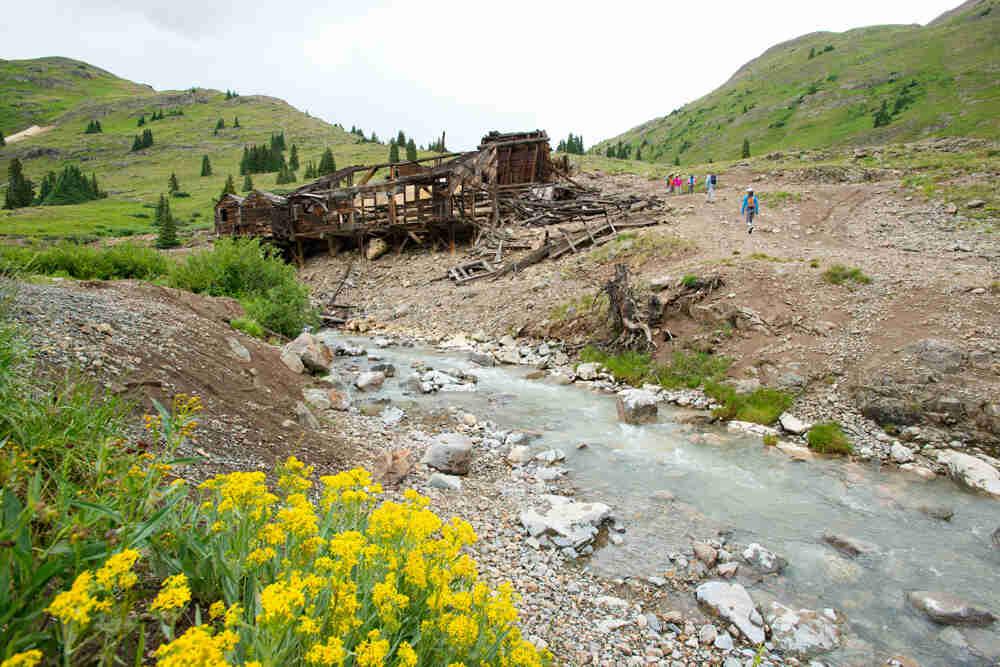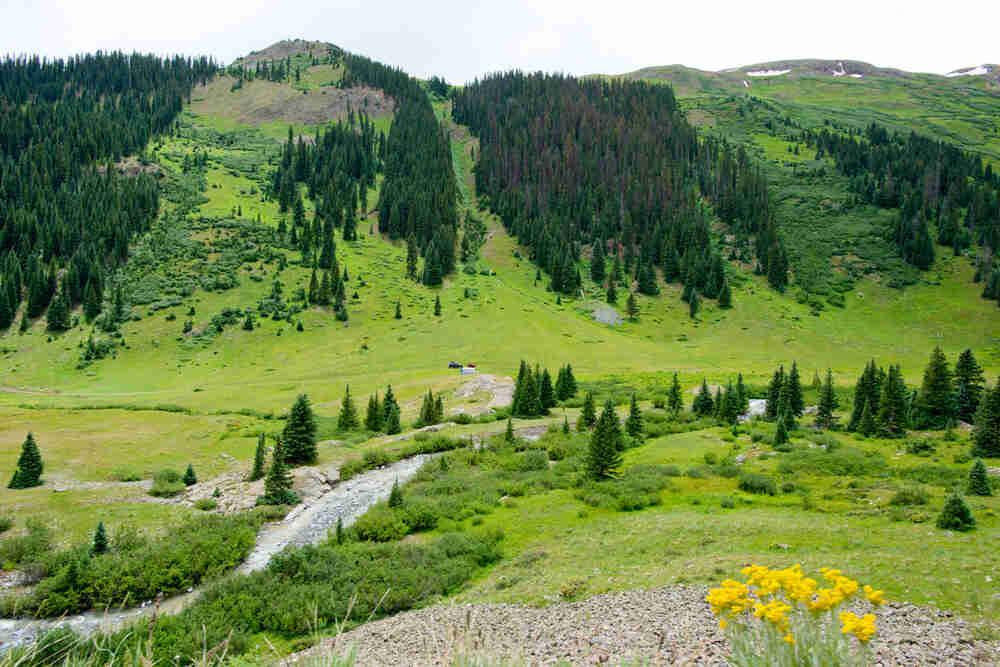Animas River
Full Article
Until recently, the Animas River—known in Spanish as “El Río de las Ánimas,” or “The River of Lost Souls”—was one of only a few undammed rivers in southwestern Colorado. The Upper Animas River Canyon bears the legacy of the longest hard-rock mining operations in southwestern Colorado. The mineral-rich geology of the San Juan Mountains profoundly shaped the natural and human histories of the Animas watershed. Moreover, the Animas River provides Coloradans a prism through which to view humanity’s historic, and often troubled, relationship with the sensitive ecosystems of the southwest Rocky Mountains.
Anatomy of a River
The Animas River originates at Animas Forks northeast of Silverton at an elevation of 11,120 feet and flows southward to Farmington, New Mexico, where it joins the San Juan River, which ultimately flows to the Colorado. In its course, the Animas travels from high alpine to dry desert environments, undergoing many changes in its physical, chemical, and biological attributes.
The rate and volume of stream flow in the Animas vary greatly by season and year. The typical seasonal minimum stream flow occurs during the winter months of November through March. The seasonal maximum occurs during the spring snowmelt period of late April through early June. The greatest stream flows in the Animas have occurred not as a result of the spring snowmelt but during the occasional late summer and early fall floods, which result from the monsoon rains this area receives. The largest of these floods on record came on October 5, 1911.
From the river’s origin to Baker’s Bridge, north of Durango, the gradient of the Animas varies from steep to moderate. The Animas flows through Durango, where its gradient moderates, and continues in that manner for the rest of its course within Colorado. The upper Animas’s high altitude; many tributaries; steep gradient; and narrow, shady canyons keep the water temperature low even in summer. However, when the river reaches the valley below Baker’s Bridge, it slows and meanders back and forth in the warmth of the sun, and the water temperature rises.
Mining’s Legacy
The Animas bears the San Juan’s legacy of mining to this day. The persistence of heavy metals in the Animas watershed affects aquatic life along most of the Animas. In the upper Animas watershed, acidic runoff containing toxic levels of heavy metals comes from several sources. In the Silverton area and northward extensive amounts of pulverized mine tailings and exposed ore deposits leach sulfides of iron, copper, antimony, arsenic, and zinc into the groundwater and the greater Animas watershed. When iron pyrite (fool’s gold) in these deposits is exposed to the atmosphere directly or indirectly, it undergoes a series of reactions with water and oxygen to produce ferric hydroxide and sulfuric acid. These reactions start in the ore deposits and continue within the streams that drain them. Ferric hydroxide is insoluble and coats the rocks of stream beds with a light yellow to orange precipitate often called “yellow boy.”
Mining has received more attention than any other source of pollution in the upper Animas watershed. Mining activities exposed large amounts of ore deposits in several ways. Miners moved large amounts of mineral-rich rocks to the surface of the earth. They discarded most of this rock and debris near the adits (the opening at the surface), where it became exposed to the atmosphere and weather, flushing mineral toxins to the streams below. Miners disposed of the mine tailings, a fine gray mineral powder suspended in water, by discharging the refuse into the nearest stream. This practice once caused severe pollution of the Animas River until mining engineers constructed tailing ponds to impound the mineral sludge.
Upstream of Silverton, the Animas River is noticeably affected by the extensive mining that has occurred in this portion of the watershed over the past 120 years. Water quality deteriorates markedly below Silverton because two tributaries, Mineral Creek and Cement Creek, enter the Animas in this area. Both creeks contain very high levels of sulfuric acid, which prevent aquatic organisms from living in them. These tributaries contain dissolved iron and heavy metal volumes many times greater than what the Animas has absorbed above the mouths of the two creeks.
Fortunately, the volume of water discharged into the Animas River by Cement and Mineral Creeks is low compared to the amount in the main stream. Furthermore, their polluted waters are greatly diluted by the many tributaries between Silverton and Rockwood. Nevertheless, the Animas has very poor water quality for many miles downstream of Cement and Mineral Creeks. This fact can be verified simply by observing the stream from the narrow-gauge Durango-Silverton train. As the train approaches Silverton, the stream bed changes from the usual dark olive color to light tan and finally to orange.
Aquatic Wildlife and Tourism
The Animas River within and immediately below Durango is well known as a trout fishery. Both rainbow trout and brown trout are present in this stretch of river. The Animas trout fishery in Durango is wholly artificial. Each year, Colorado Parks and Wildlife releases nearly 12,000 rainbow trout into the Animas. Fish dispersed from the stocking program in Durango produce the sparse population of brown and rainbow trout for several miles both upstream and downstream of town. An inconspicuous but interesting native fish in the Animas River and its tributaries is a small bottom-dweller called the mottled sculpin (Cottus bairdi), which thrives only in clean, cobble-bedded mountain streams.
Despite poor water quality in its upper reaches, throughout much of its length the Animas River is a beautiful and ecologically productive stream. It supports extensive plant and animal communities in its riparian zone. Water from the Animas irrigates many farms and furnishes towns with municipal water supplies. Spring and summer flows create whitewater sports and recreation opportunities. Thus, the Animas River is a precious resource worthy of protection and improvement through conservation and pollution control.
2015 EPA Spill
On August 5, 2015, the toxic legacy of mining in the San Juans revisited the Animas River when the US Environmental Protection Agency (EPA) inadvertently released more than 3 million gallons of water that had been trapped in an abandoned mine. The water—which was laced with heavy metals such as iron, arsenic, and lead—escaped when workers breached materials that they did not realize were holding back the contaminated water.
The Animas River immediately turned orange as the contaminated water devastated one of this region’s most important watersheds. The heavy metals in the spill will persist in the sediments of the river for years to come. Clean water will flush pollutants downstream, and eventually much of the pollution will be trapped behind dams along the Colorado River, settling in lake-bottom sediments. Cleaner river water will continue to flow down the Colorado to Phoenix, Las Vegas, Los Angeles, San Diego, and other western cities.
In the short term, water sampling has protected the drinking-water supplies of communities along the Animas River. Aquatic wildlife has been and will continue to be tested for quite some time to assess the safety of eating fish from the river’s contaminated reaches. The August 2015 spill has drawn attention to Colorado’s troubled mining legacy, forcing land management agencies to reassess how historic mining communities deal with the hundreds of abandoned mines in southwest Colorado (and thousands more in the West) that hold vast quantities of water polluted by heavy metals. The cost of cleanup in Colorado and the rest of the United States will be astronomical. The terrible results of the EPA’s attempts to clean up just one mine show the complications of undoing the toxic legacy of mining across the West. Ultimately, the images of orange-colored water flowing through beautiful stretches of Colorado will serve as a reminder of the challenges faced in addressing the environmental legacy of the Centennial State’s mining past.
Adapted from Preston Somers and Lisa Floyd-Hanna, “Wetlands, Riparian Habitats, and Rivers,” in The Western San Juan Mountains: Their Geology, Ecology, and Human History, ed. Rob Blair (Boulder: University Press of Colorado, 1996) and Tom Cech, “The Animas River Tragedy” (Boulder: University Press of Colorado, 2015).

















